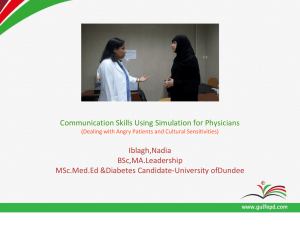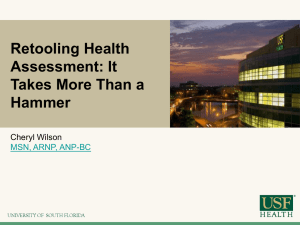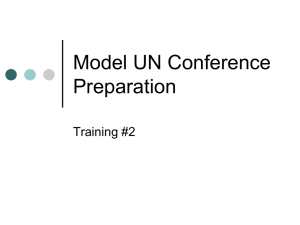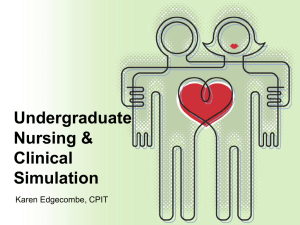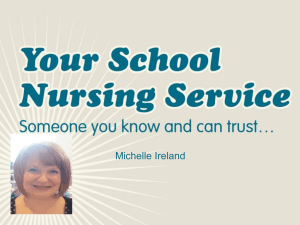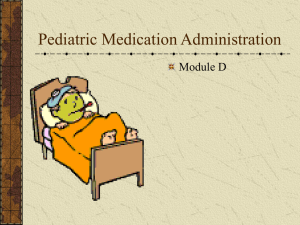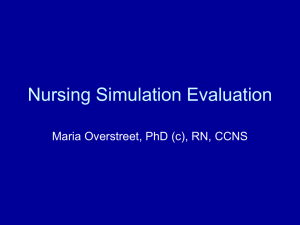Branding in the Digital Age
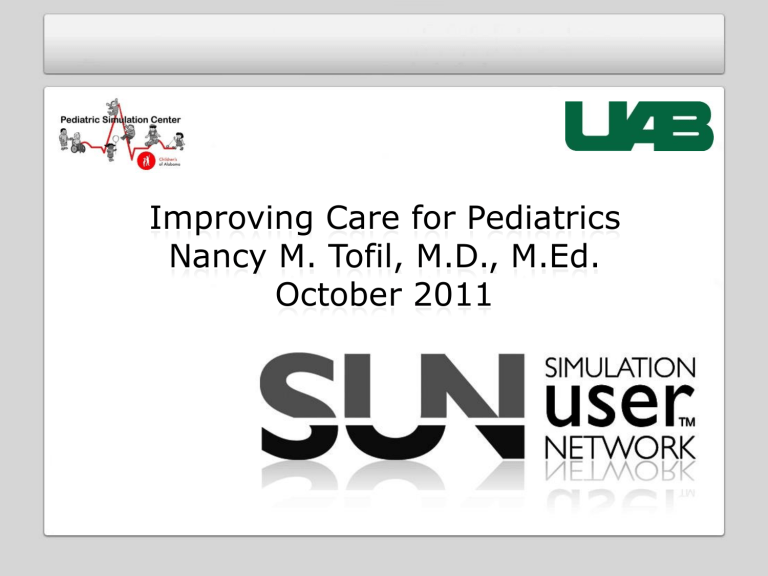
Improving Care for Pediatrics
Nancy M. Tofil, M.D., M.Ed.
October 2011
Disclosure
• I have no conflict of interests to disclose
Overview
0-5min Introduction/Turning Point Slides
5-15min Objectives
15-45min Review Pediatric courses and opportunities
45-60min TAPPS – List barriers and discuss strategies to overcome to overcome the barriers
60-75min Wrap-up / Top 10
How long have you been involved in simulation?
17% 17% 17% 17% 17% 17%
1.
0-6months
2.
6-12months
3.
12-18 months
4.
18-24 months
5.
2-5 years
6.
> 5years
0-
6month s
6-
12mont hs
12-18 months
18-24 months
2-5 years
>
5years
What is your role?
20% 20% 20% 20% 20%
1.
Simulation technologist
2.
Nurse educator
3.
Physician/ Advanced provider
4.
Administrator
5.
Other
S im ul at io n te c.
..
N ur se
e du ca to r
P hy si ci an
/ A dv
...
A dm in is tr at or
O th er
4.
5.
6.
1.
2.
3.
Nurse
Medical Student
Resident
Staff Physician
EMT
Other
Who is your primary learner?
17% 17% 17% 17% 17% 17%
N ur se
M ed ic al
S tu de n.
..
R es id en ts
S ta ff
P hy si ci a.
..
E
M
T
O th er
Where is your center located?
1.
Free standing
2.
In hospital
3.
In nursing or allied health school
4.
In medical school
5.
Other
20% 20% 20% 20% 20%
F re e st an di ng
In
h os pi ta
In l
n ur si ng
o r
...
In
m ed ic al
s ch
...
O th er
Which high-fidelity pediatric simulators do you have?
25% 25% 25% 25%
1.
Laerdal SimBaby
2.
Laerdal SimNewB
3.
METI Child
4.
Gaumard
5.
More than one type
6.
None yet
L ae rd al
M
ET
I
G au m ar d
M or e th an
o ne
..
.
What do you feel is the biggest obstacle you face concerning moving simulation forward at your institution?
1.
Financial related
2.
Technical knowledge
3.
Time constraints
4.
Hospital support
What is your primary goal from this workshop?
1.
Programming Advice
2.
Ideas for pediatric sim courses
3.
Strategies to move your center ahead
4.
Product advice
5.
Obtain new scenarios
6.
Other
Learning Objectives
1. Discuss the medical/legal environment in the pediatrics area
2. Identify issues specific to pediatric care
3. Describe the history of pediatric simulation
4. Describe the role of simulation in providing quality pediatric education
5. Discuss collaboration with multidisciplinary leadership
6. Describe how to plan and implement pediatric simulation
7. Define measurable objectives for success
Medical/Legal Environment
1. Patient safety
2. Resident duty hours
3. Transition of responsibility to fellows and attendings
4. Nursing students less exposure
5. New nurses less skilled
Issues Specific to Pediatrics
• Multiple sizes
• Multiple normal values
– Vital Signs
– Laboratory Values
– Radiograph findings
• Many patients unable to explain their concerns
• Interaction of care givers
• Social concerns
• Kids are never supposed to die
History of Pediatric Simulation
• Laerdal SimBaby – released 2005
• Laerdal SimNewB – released 2009
• METI Child – released 2006
• Gaumard HAL – released early 2000’s
• Laerdal SimChild - soon
• Always behind adult technology
• Never will have as much potential profit
Role of Simulation in Providing
Quality Pediatric Education
12
10
8
6
4
2
0
1. Clinical
Education
Inefficient
2. No Debriefing
3. No scheduled admissions
First Year Second Year Third Year Fourth Year
Years after professional degree
Old
New
1
Role of Simulation in Providing
Quality Pediatric Education
• John Dewey, “All genuine education comes about through experience but not all experience educates and some experience mis-educates”
• Experience is the backbone of adult learning theory
Kolb’s Experiential Learning Cycle
*
Simulation
Concrete
Experience
Practicing
1.Standardize exposure
2.Scheduled debriefing
Active experimentation
Abstract conceptualization
Relating to actual situations, developing rules, algorithms
*Kurt Lewen
Reflective
Observation
Debriefing
Children’s of Alabama Pediatric Simulation Center
• Began August 2007
• 8 Mannequins
• 3 Simulation rooms
• Conference room
• Audiovisual capability in all rooms
• Storage
15,000 learners
• SimBaby x2
• SimNewB
• SimMan
• SimMan Essential
• METI PediaSim
• Gaumard Pediatric
Hal 1 Year
• Gaumard Pediatric
Hal 5 Year
Our Mannequins
Multidisciplinary Courses
1.
Radiology (Attending and Technologist)
2.
ECMO (ECMO Team)
3.
PICU (Physician, Nurse and Pharmacy)
4.
Mock Code (Code Team)
5.
Trauma (Trauma Team)
6.
Death and Dying (Physician, Nurse, Social Work and
Chaplain)
7.
Forensic Evidence (Physician, Nurse)
8.
Medical Student Clerkship (Medical, Nursing and
Pharmacy Students)
9.
Sedation (Physician, Nurse, Technologist)
10. Cardiovascular (Physician, Nurse Practitioner, Nurse)
ECMO
PICU
Mock Code
Trauma
Death and Dying
Forensics – Sexual Abuse Evidence Collection
1. Orthopedics
2. Anesthesia and CRNA
3. Pharmacy Student
4. PICU Nursing
5. Solid Organ Transplant Nursing
6. Dialysis Nursing
7. NICU Nursing
“Silo” Courses
Orthopedics
Anesthesia and CRNA
NICU Nursing
Specialty Courses
1. Nursing Skills Labs (First 5 Minutes of a Code)
2. PALS
3. Geriatrics
4. NRP
5. Clinical Assistant
6. New Hire Nursing Assessment
7. Sleep Technologists
8. Nursing Mock Code Orientation
9. Home Ventilator
10. Teen Trauma Prevention
11. Medication Errors
Geriatrics
Home Ventilator Simulation for Parents
• Tracheostomy
• Intubation
• Basic Airway
• Surgical Airway
• Crisis Resource Management
• Intern Skills
• ENT Foreign Body Removal
Workshops
Basic & Advanced Airway
ENT Foreign Body Retrieval
Intern Skills
Where to begin
• Request comes in or need identified
• Face to face meeting
• Content expert identified
• Learners identified
• Goals and objectives
• What simulation can and cannot do
• Specific cases discussed
IDEAS FOR CASES
1. Sentinel events
2. Near misses
3. Rare events (contrast reactions)
4. Safety & equipment issues
5. Requests
6. Codes
7. Premature Closure
8. Hand offs
Process
• Who? Learners, content expert, simulation staff
• What? Objectives, take away points
• When? Frequency
• Where? Simulation Center, in situ, somewhere else
• Why? Change in knowledge, skills, attitudes
• How? Moulage, labs, xrays, equipment
RESOURCES
1. Online: forms, scenarios, programming, moulage
2. Internal: staff
3. Networking
4. Organizations
5. List serves
• Moulage
• Family members
• Xrays, labs, ECG
• Clothes, wigs, toys, eyeglasses
• Voices
• Use real equipment (no pretending)
• Unusual distracters (impaired clinician, family issues)
Make It Interesting
Moulage
Accessorize
Evaluation: Generic
I am a
• MD
• RN
• Resp Therapy
• Pharmacist
• Radiology Tech
• Nursing Student
• Medical Student
• Chaplain
• Social Work
• Other_______
I found to be valuable learning experience.
Debriefing and group discussion were valuable learning
Experiences.
I will be able to apply what I have learned in my work position/job.
I was challenged in my thinking and decision-making skills.
I developed a better understanding of the management of pediatric disorders/emergencies.
This experience has increased my confidence level in pediatric disorders/emergencies
This experience has increased my skill level in pediatric disorders/emergencies.
I feel better prepared to care for real pediatric patients.
I learned as much from observing my peers as I did when I was actively involved in caring for the simulated patient.
I would recommend this program to others.
Agree Neither Agree nor Disagree
Disagree
The Instructor(s) was knowledgeable about the subject(s) presented.
My personal objectives for this course were met.
Evaluation
1.
Do you feel your participation in this course will improve your performance as you encounter medical complications in the actual clinic setting?
2.
Two things I liked/learned today: a) b)
3.
Two things I wish we had focused on or that could be improved: a) b)
Comment/Suggestions/Recommendations:
TAPPS
• TAPPS – Think Aloud Paired Problem Solving 1
• Active Learning Technique
• Pair up
• Discuss proposed problem
• As instructor state, “We will do this exercise for
___ minutes. I will give you a 1 min heads up.
At the completion of the exercise I will call on some groups to share their thoughts. Does anyone have any questions before we get started.”
1. Harvey Brighton
Top 10 Things that Helped our Simulation
Center to Succeed
10. Simulator Voice
– 10W Guitar Amp ($60)
– RadioShack 170 MHZ wireless lapel microphone ($50)
– 72inch LPM cable ($5)
PRICELESS
9. Caregiver (parent, spouse, child)
– Hospital volunteer
– Medical student
Top 10
8. Free/ Nearly Free Supplies
– X-rays
– Laboratory reports
– Costumes (thrift stores)
– Trash bins (Stroller, IV pumps)
– Expired medical supplies
Top 10
7. Short scenarios (10-15min) and long debriefings (20-45min)
– Start with scenarios you feel most comfortable with and expand from there
– Same stem for multiple learners – make it more gray for more advanced learners
• JW, F8 def
– Change rhythms
Top 10
6. The Basic Assumption
Everyone participating in activities at the Children’s
Hospital Pediatric Simulation Center is intelligent, welltrained and dedicated to improve their care for children.
1
Top 10
1. Adapted from Center for Medical Simulation, Boston MA
5. Relatively simple video system
– Video-switcher
• Picture in Picture
– Apple – I Movie
Top 10
4. Weekly simulation team meetings
– Keeps everyone accountable to each other
Top 10
3. Make friends – High and Low Places
– Housecleaning
– Pharmacy
– Engineering
– Security
– Hospital volunteers
– Hospital CEO
Top 10
2. Candy!!
– Everyone learns more when fed!!
Top 10
Top 10
1. Have fun and keep it simple
Celebrate Success
